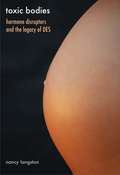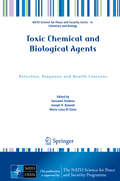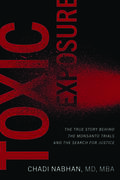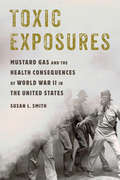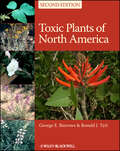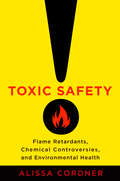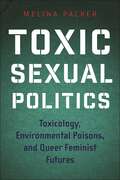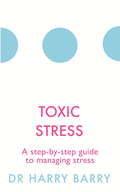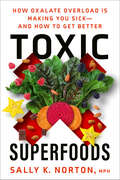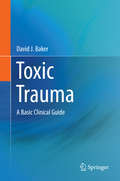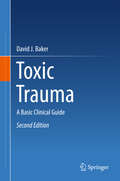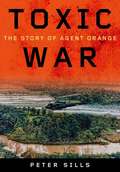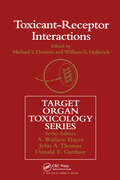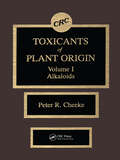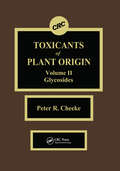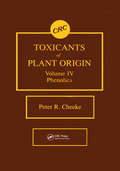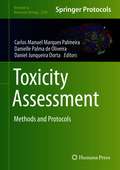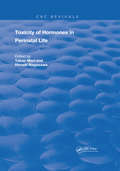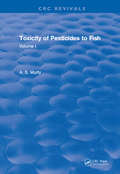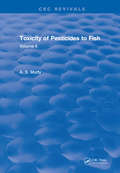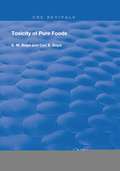- Table View
- List View
Toxic Bodies: Hormone Disruptors and the Legacy of DES
by Nancy LangstonIn 1941 the Food and Drug Administration approved the use of diethylstilbestrol (DES), the first synthetic chemical to be marketed as an estrogen and one of the first to be identified as a hormone disruptor--a chemical that mimics hormones. Although researchers knew that DES caused cancer and disrupted sexual development, doctors prescribed it for millions of women, initially for menopause and then for miscarriage, while farmers gave cattle the hormone to promote rapid weight gain. Its residues, and those of other chemicals, in the American food supply are changing the internal ecosystems of human, livestock, and wildlife bodies in increasingly troubling ways. In this gripping exploration, Nancy Langston shows how these chemicals have penetrated into every aspect of our bodies and ecosystems, yet the U. S. government has largely failed to regulate them and has skillfully manipulated scientific uncertainty to delay regulation. Personally affected by endocrine disruptors, Langston argues that the FDA needs to institute proper regulation of these commonly produced synthetic chemicals.
Toxic Chemical and Biological Agents: Detection, Diagnosis and Health Concerns (NATO Science for Peace and Security Series A: Chemistry and Biology)
by Joseph H. Banoub Giovanni Sindona Maria Luisa Di GioiaThis book critically assesses the current state of knowledge on new and important detection technologies, e.g. mass spectrometry, tandem mass spectrometry, biosensor detection and tissue imaging, in connection with toxic chemical and biological agents. In general, the main topics discussed concern the risks and consequences of chemical and biological agents for human health in general, with special emphasis on all biochemical and metabolic pathways including the reproductive system. The exposome, genetic risks and the environment, various health hazard agents, risk assessment, environmental assessment and preparedness, and analysis of sub-lethal effects at the molecular level are also discussed. In closing, the book provides comprehensive information on the diagnosis of exposure, and on health concerns related to toxic chemical and biological agents.
Toxic Disruptions: Polycystic Ovary Syndrome in Urban India
by Gauri S. PathakThis book provides a unique ethnographic account of women living with polycystic ovary syndrome (PCOS) in India. It examines how contaminated environments and political–economic changes render urban middle-class women in India vulnerable to PCOS, a condition which has the potential to disrupt conventional, normative feminine biographies of marriage and childbearing. The volume revolves around two main themes: how toxic landscapes, the endocrine disrupting chemicals suffusing them, and the political–economic environments related to them are linked to endocrine disorders such as PCOS; and how the biosocial disruptions caused by PCOS are both affecting women and reflective of changes in contemporary urban India. The author draws on anthropological fieldwork to investigate these connections through a fresh approach, combining a political ecological framework with perspectives from the anthropology of toxic exposures and health–environment systems. The first of its kind, this volume will be indispensable to students and researchers of anthropology, particularly medical anthropology, medical sociology, human geography, science and technology studies, medical humanities, health–environment systems, endocrine disorders, public health, and South Asian studies.
Toxic Exposure: The True Story behind the Monsanto Trials and the Search for Justice
by Chadi NabhanA behind-the-scenes look inside three key trials involving Monsanto's weed killer Roundup, cancer, and the search for justice—written by an expert witness medical oncologist who lived it all.For years, Monsanto declared that their product Roundup, the world's most widely used weed killer, was safe. But that all changed in 2015, when the International Agency for Research on Cancer (IARC) analyzed data from scientific studies and concluded that glyphosate, the active ingredient in Roundup, is probably carcinogenic. The Environmental Protection Agency (EPA) disagreed, other regulatory agencies got involved, and scientists clamored to understand the link between glyphosate and cancer.Toxic Exposure tells the true story of numerous patients who developed non-Hodgkin lymphoma, a form of cancer, after using Roundup and their ensuing trials against Monsanto (now owned by Bayer, one of the largest agrochemical companies in the world). Written by Chadi Nabhan, MD, MBA, a cancer specialist, this is the only book written by an expert physician witness who testified in the first three trials against Monsanto.Dr. Nabhan takes the reader behind the scenes of these pivotal trials, explaining key features of the cases, including how Monsanto downplayed the IARC's scientific conclusions, may have worked to change how the EPA classified glyphosate, and conducted extensive PR campaigns designed to minimize the public's perception of the negative health effects of its product. He also provides details about the other expert witnesses who reviewed the evidence, analyzed the science, and stood up to this agricultural behemoth in the courtroom. Dr. Nabhan tells the inside story of corporate influence, courtroom drama, legal discourse, monumental verdicts, and the ensuing media frenzy surrounding this massive uncovering of the truth and the years of scientific and legal work that led up to it.
Toxic Exposures: Contested Illnesses and the Environmental Health Movement
by Phil BrownThe increase in environmentally induced diseases and the loosening of regulation and safety measures have inspired a massive challenge to established ways of looking at health and the environment. Communities with disease clusters, women facing a growing breast cancer incidence rate, and people of color concerned about the asthma epidemic have become critical of biomedical models that emphasize the role of genetic makeup and individual lifestyle practices. Likewise, scientists have lost patience with their colleagues' and government's failure to adequately address environmental health issues and to safeguard research from corporate manipulation.Focusing specifically on breast cancer, asthma, and Gulf War-related health conditions-"contested illnesses" that have generated intense debate in the medical and political communities-Phil Brown shows how these concerns have launched an environmental health movement that has revolutionized scientific thinking and policy. Before the last three decades of widespread activism regarding toxic exposures, people had little opportunity to get information. Few sympathetic professionals were available, the scientific knowledge base was weak, government agencies were largely unprepared, laypeople were not considered bearers of useful knowledge, and ordinary people lacked their own resources for discovery and action.Brown argues that organized social movements are crucial in recognizing and acting to combat environmental diseases. His book draws on environmental and medical sociology, environmental justice, environmental health science, and social movement studies to show how citizen-science alliances have fought to overturn dominant epidemiological paradigms. His probing look at the ways scientific findings are made available to the public and the changing nature of policy offers a new perspective on health and the environment and the relationship among people, knowledge, power, and authority.
Toxic Exposures: Mustard Gas and the Health Consequences of World War II in the United States
by Susan L. SmithMustard gas is typically associated with the horrors of World War I battlefields and trenches, where chemical weapons were responsible for tens of thousands of deaths. Few realize, however, that mustard gas had a resurgence during the Second World War, when its uses and effects were widespread and insidious. Toxic Exposures tells the shocking story of how the United States and its allies intentionally subjected thousands of their own servicemen to poison gas as part of their preparation for chemical warfare. In addition, it reveals the racialized dimension of these mustard gas experiments, as scientists tested whether the effects of toxic exposure might vary between Asian, Hispanic, black, and white Americans. Drawing from once-classified American and Canadian government records, military reports, scientists' papers, and veterans' testimony, historian Susan L. Smith explores not only the human cost of this research, but also the environmental degradation caused by ocean dumping of unwanted mustard gas. As she assesses the poisonous legacy of these chemical warfare experiments, Smith also considers their surprising impact on the origins of chemotherapy as cancer treatment and the development of veterans' rights movements. Toxic Exposures thus traces the scars left when the interests of national security and scientific curiosity battled with medical ethics and human rights.
Toxic Plants of North America
by George E. Burrows Ronald J. TyrlToxic Plants of North America, Second Edition is an up-to-date, comprehensive reference for both wild and cultivated toxic plants on the North American continent. In addition to compiling and presenting information about the toxicology and classification of these plants published in the years since the appearance of the first edition, this edition significantly expands coverage of human and wildlife--both free-roaming and captive--intoxications and the roles of secondary compounds and fungal endophytes in plant intoxications.More than 2,700 new literature citations document identification of previously unknown toxicants, mechanisms of intoxication, additional reports of intoxication problems, and significant changes in the classification of plant families and genera and associated changes in plant nomenclature. Toxic Plants of North America, Second Edition is a comprehensive, essential resource for veterinarians, toxicologists, agricultural extension agents, animal scientists, and poison control professionals.
Toxic Safety: Flame Retardants, Chemical Controversies, and Environmental Health
by Alissa CordnerInitially marketed as a life-saving advancement, flame retardants are now mired in controversy. Some argue that data show the chemicals are unsafe while others continue to support their use. The tactics of each side have far-reaching consequences for how we interpret new scientific discoveries.An experienced environmental sociologist, Alissa Cordner conducts more than a hundred interviews with activists, scientists, regulators, and industry professionals to isolate the social, scientific, economic, and political forces influencing environmental health policy today. Introducing "strategic science translation," she describes how stakeholders use scientific evidence to support nonscientific goals and construct "conceptual risk formulas" to shape risk assessment and the interpretation of empirical evidence. A revelatory text for public-health advocates, Toxic Safety demonstrates that while all parties interested in health issues use science to support their claims, they do not compete on a level playing field and even good intentions can have deleterious effects.
Toxic Sexual Politics: Toxicology, Environmental Poisons, and Queer Feminist Futures (Health, Society, and Inequality)
by Melina PackerA bold exposé of how the very foundation of toxicology has been contaminated by sexist and racist ideologiesThe first critical understanding of the field of toxicology from a feminist and antiracist perspective, Toxic Sexual Politics asserts that the science of toxicants must be held accountable for the uneven distribution of toxic pollution along racial and sexual lines. Drawing upon in-depth interviews and extensive ethnographic and archival research, including participant observations in toxicology classrooms, conferences, and laboratories, Melina Packer urges environmental health advocates to place toxicant science within its masculinist, militarist, and eugenicist history.Toxic Sexual Politics shows how the founding fathers of U.S. toxicology were ideologically aligned with the chemical industry, inventing a science that could “make chemicals safe,” as opposed to one that could adequately protect planetary health from toxicants’ hazards. While many toxicologists today are critical of the chemical industry, they continue to rely on the highly limited tools of toxicology as accurate measures of toxicity, as do government regulators, the courts, and environmental advocates.Unlike most critiques of the chemical industry and narratives of environmental health movements, Toxic Sexual Politics refuses to take the science at face value. By focusing on the sexist, racist, and ableist biases reinforced by toxicology, Packer powerfully argues that this scientific discipline reproduces the very same white supremacist and heterosexist logics that generated environmental injustices in the first place. The field of toxicology can explicitly confront chemical corporate power by building from queer, feminist, anti-ableist, and antiracist movements for environmental and reproductive justice.
Toxic Stress: A step-by-step guide to managing stress (The Flag Series #5)
by Dr Harry Barry'This is a truly ground-breaking, innovative and profoundly enlightening work. Dr Harry Barry leads the reader on a holistic journey through the mind and its emotional responses in a way that is both explorative and explanatory' National Counselling Institute of Ireland'It's that rare thing - a medical book that can be read by lay people and health professionals alike. Dr Barry demystifies subjects that touch so many of our lives and he does so with compassion, wisdom and vast professional knowledge' Cathy Kelly, bestselling author and UNICEF ambassadorIdentify and manage stress with this practical, seven-step programme by bestselling author and GP, Dr Harry BarryIn the world we live in, stress comes from a multiple number of sources, including pressures at work, relationship difficulties and illness. Most people can usually take what life throws at them; but when stress builds up, it can overwhelm an individual and lead to potentially serious health problems. Toxic stress is an indispensable tool on coping with the stresses of modern life. By identifying the different kinds of stress and in particular the dangers of 'toxic' stress, Dr Barry shows us how to discover where our stress is coming from and how we can effectively confront, manage and reduce it in our lives.Previously published as Flagging Stress: Toxic Stress and How to Avoid It, this edition has been fully revised and updated.
Toxic Superfoods: How Oxalate Overload Is Making You Sick--and How to Get Better
by Sally K. NortonAn acclaimed nutrition educator reveals how the foods you&’re eating to get healthy might be making you sick. &“Sally Norton&’s well-researched book makes a truly important contribution to the literature in revealing just how much oxalates can damage the human body.&”—Nina Teicholz, author of The Big Fat Surprise If you&’re eating a healthy diet and you&’re still dealing with fatigue, inflammation, anxiety, recurrent injuries, or chronic pain, the problem could be your spinach, almonds, sweet potatoes, and other trusted plant foods. And your key to vibrant health may be quitting these so-called superfoods. After suffering for decades from chronic health problems, nutrition educator Sally K. Norton, MPH, discovered that the culprits were the chemical toxins called oxalates lurking within her &“healthy,&” organic plant-heavy diet. She shines light on how our modern diets are overloaded with oxalates and offers fresh solutions including: • A complete, research-backed program to safely reverse your oxalate load • Comprehensive charts and resources on foods to avoid and better alternatives • Guidance to improve your energy, optimize mood and brain performance, and find true relief from chronic pain In this groundbreaking guide, Norton reveals that the popular dictum to &“eat more plants&” can be misleading. Toxic Superfoods gives health-seekers a chance for improved energy, optimum brain performance, graceful aging, and true relief from chronic pain.
Toxic Trauma
by David J. BakerThis book provides practical guidance to emergency personnel and others in the event of having to manage individual or mass chemical casualties as part of their work in a civilian ambulance service or hospital. The text considers the nature and basic science of the hazards faced as well as the practical management of persons exposed to chemicals and toxins (which although of biological origin behave as chemicals in terms of their effects and transmission). Individual chapters cover the development and classification of chemical toxic agents, how exposure can occur and how medical personnel should be involved in its management . There is also consideration of the nature of toxic trauma and the pathophysiological processes involved, together with a systematic approach to early and continuing management supported by specific examples of incidents. This guide is a useful practical resource for emergency medical and paramedical personnel involved in the management of mass chemical casualties and with ensuring safe operating procedures within potentially contaminated areas to prevent secondary casualties from a chemical release.
Toxic Trauma
by David J. BakerThis second edition will update readers about recent chemical agent events and address the often misrepresented relationship between chemical and biological, radiological, and nuclear weapons; this text will go beyond existing information on poisoning and clinical toxicology to provide emergency personnel and others with a holistic approach to the increasing likelihood of having to manage individual or mass exposure to industrial and chemical warfare agents as well as to work safely and avoid the risks presented to medical and nursing personnel from secondary contamination. The exposure to toxic substances can affect all systems of the body causing many pathophysiological pathways of damage that converge with those identified in conventional physical trauma, in which then, these compounded symptoms can be identified as toxic trauma. The text considers the nature and basic science of these hazards as well as the practical management of persons exposed to chemicals and toxins with unfamiliar medical conditions and who require urgent treatment (which, although the conditions are of biological origin, they behave as chemicals in terms of their effects and transmission). The approach taken will be essentially clinically--based but with explanations of the underlying mechanisms that unify the syndromes with which victims present. Mirroring the format of the first edition, individual chapters cover the development and classification of chemical toxic agents, how exposure can occur and how medical personnel should be involved in its management. There is also consideration of the nature of toxic trauma and the pathophysiological processes involved, together with a systematic approach to early and continuing management supported by specific examples of incidents. This guide is a useful practical resource for emergency medical and paramedical personnel involved in the management of mass chemical casualties and with ensuring safe operating procedures within potentially contaminated areas to prevent secondary casualties from a chemical release.
Toxic War: The Story of Agent Orange
by Peter SillsThe war in Vietnam, spanning more than twenty years, was one of the most divisive conflicts ever to envelop the United States, and its complexity and consequences did not end with the fall of Saigon in 1975. As Peter Sills demonstrates in Toxic War, veterans faced a new enemy beyond post-traumatic stress disorder or debilitating battle injuries. Many of them faced a new, more pernicious, slow-killing enemy: the cancerous effects of Agent Orange.Originally introduced by Dow and other chemical companies as a herbicide in the United States and adopted by the military as a method of deforesting the war zone of Vietnam, in order to deny the enemy cover, Agent Orange also found its way into the systems of numerous active-duty soldiers. Sills argues that manufacturers understood the dangers of this compound and did nothing to protect American soldiers.Toxic War takes the reader behind the scenes into the halls of political power and industry, where the debates about the use of Agent Orange and its potential side effects raged. In the end, the only way these veterans could seek justice was in the court of law and public opinion. Unprecedented in its access to legal, medical, and government documentation, as well as to the personal testimonies of veterans, Toxic War endeavors to explore all sides of this epic battle.
Toxic War: The Story of Agent Orange
by Peter SillsThe war in Vietnam, spanning more than twenty years, was one of the most divisive conflicts ever to envelop the United States, and its complexity and consequences did not end with the fall of Saigon in 1975. As Peter Sills demonstrates in Toxic War, veterans faced a new enemy beyond post-traumatic stress disorder or debilitating battle injuries. Many of them faced a new, more pernicious, slow-killing enemy: the cancerous effects of Agent Orange. Originally introduced by Dow and other chemical companies as a herbicide in the United States and adopted by the military as a method of deforesting the war zone of Vietnam, in order to deny the enemy cover, Agent Orange also found its way into the systems of numerous active-duty soldiers. Sills argues that manufacturers understood the dangers of this compound and did nothing to protect American soldiers.Toxic War takes the reader behind the scenes into the halls of political power and industry, where the debates about the use of Agent Orange and its potential side effects raged. In the end, the only way these veterans could seek justice was in the court of law and public opinion. Unprecedented in its access to legal, medical, and government documentation, as well as to the personal testimonies of veterans, Toxic War endeavors to explore all sides of this epic battle.
Toxicant-Receptor Interactions: Modulations of signal transduction and gene expression (Target Organ Toxicology Series)
by A.M.O. MohamedMany of the toxic effects elicited by xenobiotics can be explained at the molecular level by their interaction with receptors or by disruption or interference with receptor-mediated signal transduction pathways. This volume describes molecular approaches and reviews of current research. It provides reviews of numerous research areas which are direc
Toxicants of Plant Origin: Alkaloids, Volume I
by Peter R. CheekeThis comprehensive treatise offers an in-depth discussion of natural toxicants in plants, emphasizing their effects as defenses against herbivory. Coevolution of plants and her-bivores are covered with a detailed treatment of toxicant metabolism and systemic effects in mammalian tissues. Con-sideration of the economic importance of plant toxins, modi-fication by plant breeding, management of toxico-sis, and toxicant problems in various geographic areas are in-cluded. Each volume offers an extensive description of chemistry, biosynthesis, analysis, distribution in plants, metabolism in mam-mals and insects, and practical problems in humans and livestock.
Toxicants of Plant Origin: Glycosides, Volume II
by Peter R. CheekeThis comprehensive treatise offers an in-depth discussion of natural toxicants in plants, emphasizing their effects as defenses against herbivory. Coevolution of plants and her-bivores are covered with a detailed treatment of toxicant metabolism and systemic effects in mammalian tissues. Con-sideration of the economic importance of plant toxins, modi-fication by plant breeding, management of toxico-sis, and toxicant problems in various geographic areas are in-cluded. Each volume offers an extensive description of chemistry, biosynthesis, analysis, distribution in plants, metabolism in mam-mals and insects, and practical problems in humans and livestock.
Toxicants of Plant Origin: Phenolics, Volume IV
by Peter R. CheekeThis comprehensive treatise offers an in-depth discussion of natural toxicants in plants, emphasizing their effects as defenses against herbivory. Coevolution of plants and her-bivores are covered with a detailed treatment of toxicant metabolism and systemic effects in mammalian tissues. Con-sideration of the economic importance of plant toxins, modi-fication by plant breeding, management of toxico-sis, and toxicant problems in various geographic areas are in-cluded. Each volume offers an extensive description of chemistry, biosynthesis, analysis, distribution in plants, metabolism in mam-mals and insects, and practical problems in humans and livestock.
Toxicity Assessment: Methods and Protocols (Methods in Molecular Biology #2240)
by Carlos Manuel Marques Palmeira Danielle Palma de Oliveira Daniel Junqueira DortaThis book collects protocols from different areas of knowledge to assist in the identification of toxic effects exerted by different xenobiotics. At the same time as classical techniques are presented, modern techniques with alternative models to the use of animals are also presented. Given the ever-increasing exposure to different compounds and their effects on population health, the assessment of multiple endpoints is of utmost importance for better risk assessment, and this collection addresses that need. Written for the highly successful Methods in Molecular Biology series, chapters include introductions to their respective topics, lists of the necessary materials and reagents, step-by-step, readily reproducible laboratory protocols, and tips on troubleshooting and avoiding known pitfalls. Authoritative and practical, Toxicity Assessment: Methods and Protocols aims to serve researchers in this vast field of science as they seek to better understand the mechanisms of action of different xenobiotics.
Toxicity Of Hormones In Perinatal Life (Routledge Revivals)
by Takao Mori Hiroshi NagasawaFirst Published in 1988, this book offers a full, comprehensive guide into the toxicity of hormones during childbirth. Carefully compiled and filled with a vast repertoire of notes, diagrams, and references this book serves as a useful reference for students of midwifery, and other practitioners in their respective fields.
Toxicity Of Pesticides To Fish: Volume I
by A.S. MurtyThe present work is the first major attempt at reviewing comprehensively all the available information about the environmental fate and behaviour of the xenobiotic chemicals.
Toxicity Of Pesticides To Fish: Volume II
by MurtyThe present work is the first major attempt at reviewing comprehensively all the available information about the environmental fate and behaviour of the xenobiotic chemicals.
Toxicity Of Pure Foods (Routledge Revivals)
by E. M. BoydFirst Published in 1973, this book offers a full, comprehensive guide into the toxicology of certain foods. Carefully compiled and filled with a vast repertoire of notes, diagrams, and references this book serves as a useful reference for students of toxicology, and other practitioners in their respective fields.
Toxicity Testing Using Microorganisms (Routledge Revivals #1)
by Gabriel Bitton Bermard J. DutkaFirst Published in 1986, this two-volume set offers comprehensive insight into the testing of toxic substances using microorganisms as reference. Carefully compiled and filled with a vast repertoire of notes, diagrams, and references this book serves as a useful reference for students of medicine and other practitioners in their respective fields.
